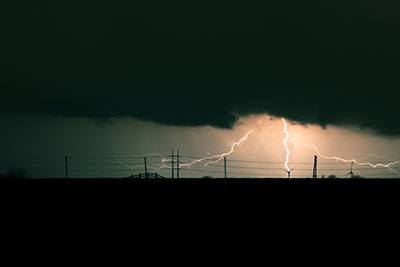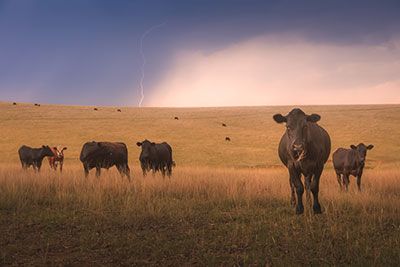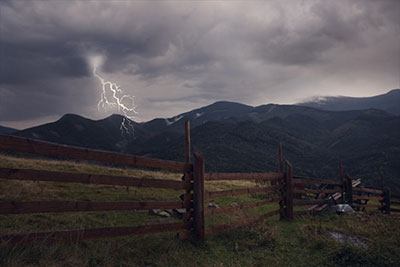Are you considering installing an electric fence to protect your property but apprehensive about the effects of lightning? You don’t have to be.
With proper planning and the right equipment, it is possible to safeguard your electric fence system against lightning using our specialized lightning protection solutions.
We’ll explain why electric fence lightning prevention is so important and provide a snapshot of what you could expect from efficient protective tools. Read on for our expert insights!
Take away key points:
- Stormy impacts can cause irreparable damage and injuries to fences and cattle
- Protect your property and animals by using lightning protection
- Follow safety steps to ensure the best fencing standards for your livestock
Table of Contents
- Electric fence protection from a lightning strike: The basics
- What does a lightning strike do to an electric fence?
- Livestock protection from lightning strikes
- Extra tips & tricks to safeguard your animals from injuries
- Help! A bad storm is coming! What shall I do?
- Investing in lightning ancestors and similar lightning protection tools
- FAQs
- Summary
If you need to finish most farm operations on time, yet might be afraid of physical damage from lightning strikes on your electric fence, you don’t need to worry.
You can read our lightning strikes and fence wire guide to learn how to properly protect your electric fences from such risks. Let’s see.
Electric fence protection from a lightning strike: The basics

Electric fences are an effective way to protect your animals and property, but they are vulnerable to storms and lightning. Lightning can cause serious damage to your electric fences and put your livestock and property at risk or even kill livestock and other animals.
To protect your valuable electronics from a particularly intense storm, it is best to use a combination of lightning arrestors, lightning diverters, and surge protectors. By installing these devices, you can divert strikes away from your fence and protect your charger from lightning surges.
One effective device is the EFL Lightning safety Diverter, which absorbs lightning and drives it away from your fence charger to the ground. The ground rod system can also prevent lightning damage coverage to your charger and installing equipment. It protects charger units & ensures your fence continues to function properly in stormy weather.
You must ensure your fence charger is properly grounded to reduce the risk of induced lightning hits. Proper ground rods can also protect your fence charger from electrical surges.
Remember, induced lightning hits are unpredictable, and easily destroy valuable electronics in your fencing. But, by taking property lightning proactive steps toward lightning protection, you can mitigate the risk of damage to your fence and keep your animals and property safe in a major storm.
What does a lightning strike do to an electric fence?
Lightning tends to follow the path of least resistance. Therefore, fences consisting of hundreds or thousands of feet of metallic wiring are highly conductive to electrical surges produced by direct strikes.
However, lightning rarely strikes the fence itself. Instead, it induces voltage along the fence wire. Such a phenomenon can happen even if the lightning hits several miles away from the fence.
Induced lightning travels along the fence seeking a path that requires minimal energy to reach the ground in the storm guard.
In electric fences, this path is through the separate ground rod system, which is located on the opposite end of the fence charger. If lightning hits the fence line, it has to travel through the charger to reach the separate ground rod. This can potentially destroy the charger.
Alternatively, lightning may damage the charger if it travels through a utility line to the outlet and into the device. Direct lightning strikes on the fence itself can harm the charger, regardless of precautions.
While physical damage to the rest of the fence is rare, it can occur if the energy arcs unexpectedly to other objects or even farm buildings. Certain trees and root systems tend to be more prone to lightning. They are highly dangerous for people and animals during a storm.
Livestock protection from lightning strikes

Although livestock in pastures during electrical storms are usually safe, intense storms can result in significant damage or loss of herds. The biggest issue is that cattle tend to gather under trees during inclement weather to get some coverage from the rain.
However, lightning usually strikes the tallest object it can locate, which can result in the electrocution of cattle congregated beneath the tree canopy. The water absorbed by tree roots and sap flowing within them makes trees great conductors, which renders the region under trees dangerous during lightning storms. Thus the lightning will make your livestock injured or even dead, as it resents an unavoidable threat.
Additionally, the ground surrounding a tree can be hazardous, as the large root systems tend to absorb energy, and the current can electrocute anything standing in the wet grass swathe. To safeguard your animals from lightning strikes, and conduct a full lightning damage coverage, move them into a grounded building to protect them from direct lightning.
Plant trees in rows rather than groups in pastures to spread out the chance for strikes and limit livestock injuries. Note that some trees with larger root systems have a higher likelihood of being struck.
Place metal feeding troughs in lower areas instead of the top of a hill to lessen the impacts. The same applies to adding ground rods. Finally, ensure your herd for lightning forces.
Extra tips & tricks to safeguard your animals from injuries
Here are some safety tips for property lightning protection:
– Provide shelter: During thunderstorms, ensure that your cattle have access to safe and secure shelter to protect them from forces.
– Avoid large trees: During thunderstorms, avoid herding your cattle near large trees as they are more susceptible to being struck by lightning.
– Stay away from metallic objects: Cows can be attracted to large, metallic objects (metal wiring, such as farm equipment. Therefore, keep them away from these objects during a thunderstorm.
Help! A bad storm is coming! What shall I do?
In the event of an electrical storm not being directly overhead, the best course of action is to first protect the livestock before working to safeguard the fence charger.
To protect the cattle, move them somewhere safe during the storm. Once that’s done, turn off the fence and disconnect it. This process will protect nearly any component of the fence. Remove the charger and other lightning protection products for the duration of the storm.
After the storm passes, reconnect the charger to test the fence, and inspect the fence line and charger for any damage, including debris falling on or around the fence. Once the fence is operational, the animals can be returned to their paddocks.
There are various lightning protection products available in the market to safeguard electric fencing from being damaged by lightning strikes. Investing in these safety measures is the path of least resistance for the electric fence and reduces the likelihood of your animals wandering off after a storm.
Investing in lightning ancestors and similar lightning protection tools

To protect your fence charger from lightning strikes, it is recommended to have the necessary equipment installed in advance.
Products such as lightning arresters, lightning diverters, and surge protectors can isolate your charger and discharge or absorb sudden energy surges caused by lightning.
Combining several of these devices is the best way to ensure complete protection for your electric fence during a storm.
1. Other lightning protection tools
A lightning Arrester is an effective form of lightning protection that transfers lightning energy into the ground. The lightning arrester may require up to an hour of installation time with additional ground rods added for optimal safety.
To add extra layers of protection, it is recommended to use Storm Guard as well for the utility line. This product attaches to fence ground posts near the ground level and functions as the last point of contact for absorbing energy from a strike. Thus, it protects the charger. It requires minimal installation time (hour) and needs replacing after every strike.
In addition, the energy from a storm and a lightning bolt can also vaporize metal, to spell trouble to all components of fencing in ample pasture land. So, the proper grounding system will limit the impacts, unlike regular protection which only theoretically limits the forces.
2. Ground rods
Ground rods are essential for protecting electric fences from lightning strikes. An electric fence is essentially a conductor that can attract lightning, and without proper grounding, a single lightning strike can cause severe damage to the fence and nearby structures.
Grounding the fence with rods ensures that any excess electrical energy from a lightning strike is dispersed safely into the ground, preventing potential fires, injuries, or fatalities. Proper grounding is a crucial element of any lightning protection system, whether it’s for a residential, commercial, or industrial structure.
3. Lightning diverter
A lightning diverter is a tool used to redirect the energy from the fence to the ground before it causes damage to the construction. The lightning diverter consists of a choke coil. It’s placed between the energizer and the strike, minimizing the damage.
The lightning diverter will direct the energy through the spark gap and down to the ground bed. Finally, you must connect the lightning diverter to the top hot wire of the fence.
FAQs
What happens if lightning hits an electric fence?
The impacts travel to the ground rods through the charger, but if you don’t use the protection, it will cause damage to your fencing.
How do I protect my fence charger from lightning?
You must install devices to isolate the charger and absorb or discharge energy.
Can you use an electric fence for security?
Yes, you can use the fence for security ad it will prevent intruders from coming to your property.
Why is lightning protection important for electric fence chargers?
The impacts will destroy it unless you use protection for your charger.
Summary
The strikes can cause irreparable damage to fences and cattle, so you must ensure sufficient protection to prevent fatalities. Follow all safety steps to keep your cattle safe.
